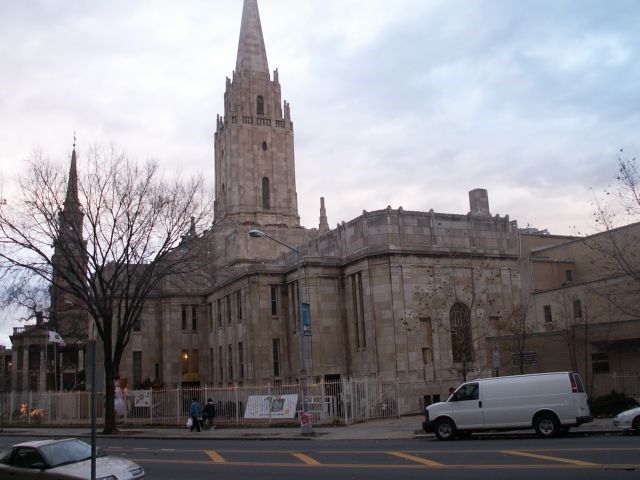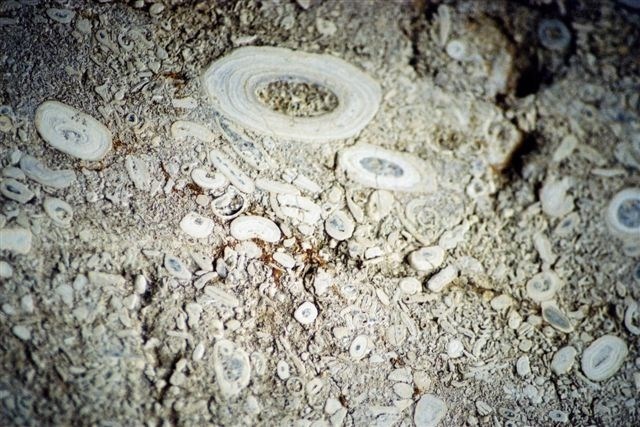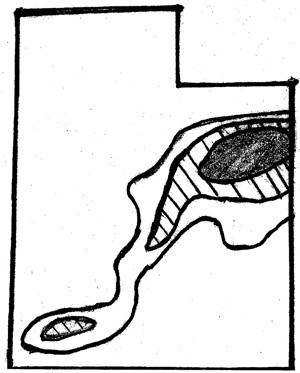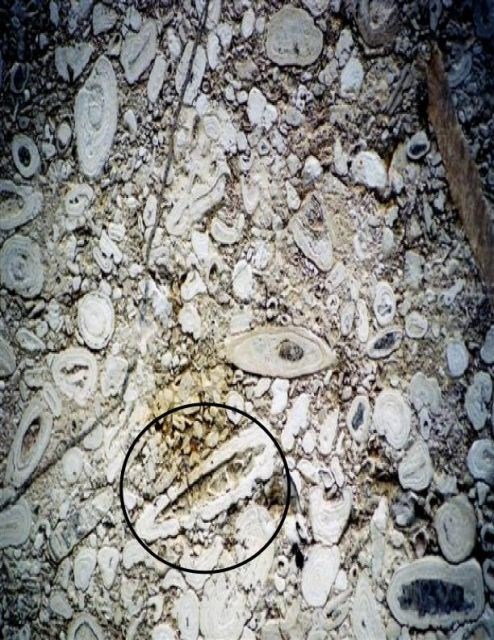It is currently a Unification Church, but the structure was built in 1933 as the first chapel of the Church of Jesus Christ of Latter Day Saints -- the Mormons -- in the District of Columbia. Two grandsons of Brigham Young contributed to its design and artwork, and the church consciously echoes the design of the great Temple in Salt Lake City.

Like many local churches, it is now surrounded by a fence. Even from a distance, however, one can see that the walls are covered with a distinctive tan/grey facing stone. A look from the sidewalk reveals a multitude of rounded shapes, roughly circles and flattened ovals, widely varied in size. Walk to the driveway at the rear of the church, on Columbia Road, where one can usually have a close look at the walls.
Note the dense masses of flattened, vaguely circular and oval shapes:

The rounded shapes, often filled with numerous concentric oval layers etched in relief, are “oncoids” (sometimes called “oncolites”). They are flattened balls of calcium-rich material created by successive layers of algae growing in the shallows of a vast, fresh-water lake in what is now the state of Utah, between 58 and 65 million years ago. They sometimes formed around other fossils, including certain common gastropods of the time, turritellas. The oncoids provide a link to an unusually youthful and unusual source for building stones – a freshwater lake during the dawn of the Age of Mammals.
The map below, which is based on a map found in Geology of Utah, p. 154, Fig. 16-1, shows the geographic scope of lake sediments during the Paleocene – cross-hatched areas have deeper deposits, and the dark, shaded area has the deepest deposits.
The birdseye “marble” of Utah is a limestone, rather than a true marble. It originated in a sequence of sediments deposited in a vast freshwater lake, approximately 66 to 58 million years ago, known as Lake Flagstaff. Lake Flagstaff extended over portions of northeastern and central Utah:

Lake Flagstaff was sufficiently large and stable that fresh water algae were able to produce reef-like structures many feet wide. Ultimately -- like all lakes -- Lake Flagstaff gradually dried and was overlain by river sediments and much later deposits.
Fossils of Algae and Turritellas
The oncoids visible in the stone represent the accretion of many concentric layers of lime created by algae. The oncoids typically formed around objects in the lake floor – snail shells, twigs, or other objects. Over time, the successive layers of algae-formed lime would form a round or flattened ovoid shape – although the flatter forms suggest the deforming pressures of rock formation, geologists believe that the flattened forms likely reflect the effects of gravity or the first sediments on top of the still-malleable balls of sediment.
Because the oncoids sometimes formed around shells, one can sometimes see evidence of another fossil inside them. For example, look closely at the photograph below, taken from the rear of the church. The circled oncoid appears to have formed around a Turritella, a common gastropod (snail) of the Paleocene:

Here, the original shell appears to have eroded away, leaving a kind of mold at the heart of the oncoid – probably due to the faster weathering of the original shell, made of aragonite, than the more resistant calcite that made up the surrounding oncoid layers.
In some cases, however, the original form of the Turritella shell has been chemically replaced with a cast made of what appears to be clear calcite. In the picture below, the apparently calcite cast of two Turritellas are easily visible to the right of the ruler. One can even make out the whorls of the spired shells, particularly in the larger Turritella
The World of Lake Flagstaff and the Early Cenozoic
The oncoids of the birdseye marble may show only the remains of algae and shells, but it also evokes a unique point in life history. The Paleocene was the first period of the Cenozoic, popularly known as “the Age of Mammals.” Only a few million years earlier at 65 million years ago, great extinctions marked the close of the Cretaceous period – most famously, ending with the sudden mass extinction of the dinosaurs. Life in Utah
during the early Cenozoic included a wide range of animals – nearly all extinct species, but recognizably closer to the dominant animals of today. Fossils of these animals have primarily been found in formations other than the Lake Flagstaff Formation, particularly in the North Horn, Duchesne River and Uinta Formations, and are likely very similar to Paleocene animals found in Wyoming and Montana. They include large herbivores, primitive mammalian predators, turtles. lizards, many birds, bats and others. These early mammals proliferated during the first 10 million years after the dinosaurs disappeared, as they occupied a wide range of ecological niches previously held by the dinosaurs. By the time of Lake Flagstaff, mammals filled the landscape, from tiny rodent-like creatures, to large (but not yet gigantic) herbivores, to large (but not yet gigantic) predators – many living near the shores of Lake Flagstaff.
The First Mormon Chapel in D.C.
The former Mormon chapel was built in 1933 to house the growing Mormon community of the Capitol. Its distinctive architectural style included vertical elements meant to evoke the original Mormon Temple in Salt Lake City. In another reference to the historical home of Mormonism, the new structure was clad with dimension stone from Utah, “birdseye marble.” The stone was quarried from a site more than 8,000 feet in elevation, in what is now the Manti-La Sal National Forest in the mountains more than 60 miles south of Salt Lake City. According to one source, the stone was transported from Utah to D.C. in twenty railcars.
The Boston Evening Transcript of November 18, 1933, declared that it was then the only building in the world constructed of such “marble.” The writer waxed rhapsodic about the new stone surfaces.
The marble has a satin hone finish and at different times of the day reflects various hues. After a heavy rain the effect is of a highly polished marble which changes, as it dries, into a hazy purple.
Sadly, the stone no longer matches this description. From a distance, it remains a handsome tan/grey appearance. Up close, the surface is deeply lined and cracked with fissures. The wear and erosion have, however, highlighted the rounded shapes of the oncoids.
The severe surface wear has been attributed to acid rain and the persistent presence of automobile exhaust from the commuter artery of 16th St. Interestingly, the geologic tour of Salt Lake City posted on the website of the Utah Geological Survey describes two buildings as using “birdseye marble” – both for interior walls.
Changes in the neighborhood, the growing needs of the Mormon community, and the prospect of costly repairs to the walls, led to the end of services in 1975 and the sale of the chapel, which was purchased by the Unification Church in 1977. The Mormons constructed a new, larger chapel in suburban Bethesda – a structure that also provides a visible reference to the temple in Salt Lake City.
Logging Requirements
1. How big are the oncoid fossils in the building? Are they relatively the same size or different?
2. Do you notice any signs of erosion on the limestone in this building?
3. Do you see any other types of fossils in this stone?
4. Where did this limestone come from?
5. Post a picture of yourself (face not required) or a personal item at the building.